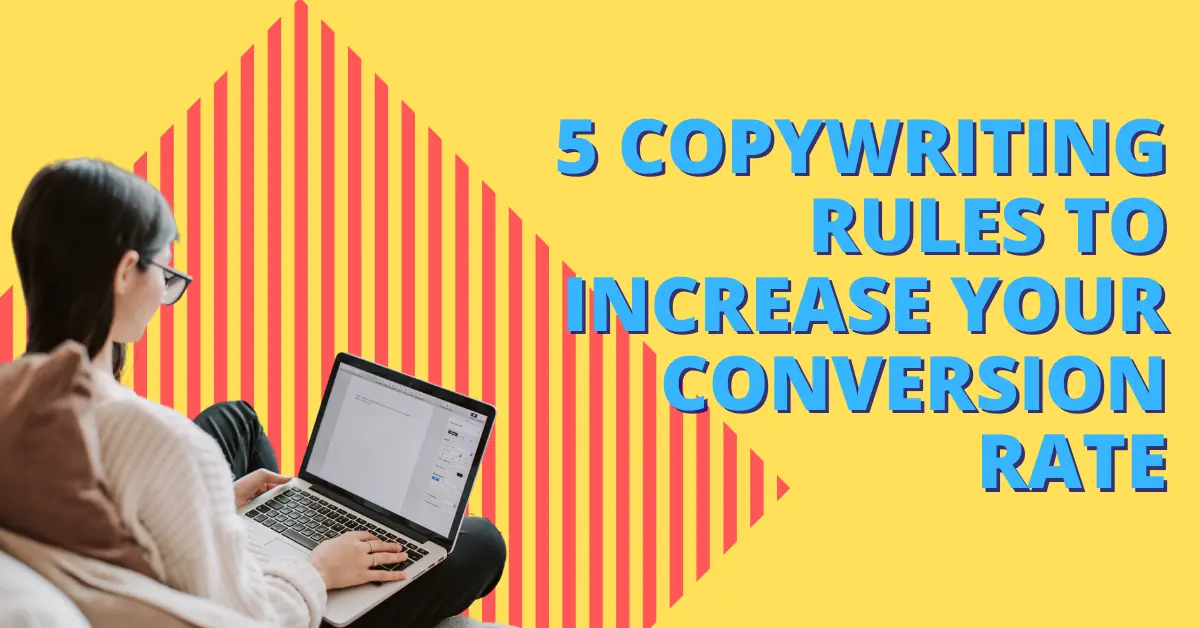Whether you’re creating a landing page with 50 words or a blog post containing 1.000 words, the way you write does matter. There’s a strong correlation between conversions and copywriting, and some sources even say that it’s possible to increase conversions by 113% - or more! - with powerful copy.
The words that you present to your audience (and the way you present them) have the ability to turn a skeptical reader into a new customer, client, or follower. Even if your current marketing strategy is generating twice as many leads, it won’t matter if your written content isn’t converting those leads.
If getting more conversions is on your agenda, follow these 5 copywriting rules for creating strong copy that is sure to increase your conversion rate.

1. Your Writing Should Tell a Story
Although you don’t have to start with “Once upon a time…” or finish with “and they lived happily ever after…”, one of the best ways to increase conversions is to tell a story with your copywriting.
Right about now you’re probably wondering, what’s the story I should be telling?
Well, that’s easy. Tell your story! Your copy should focus on telling the story behind your brand and getting across to the audience why you should matter to them and what you can do for them.
You can literally write the story behind your brand or you can make it metaphorical with actual storytelling - fictional characters and all. Here are a few of the most effective storytelling techniques for upping conversion rates:
- Refer to case studies that relate to your product/service
- Write about real-life examples to illustrate your point
- Create a strong “About” page to tell your own personal story
Why Use Storytelling?
In copywriting, storytelling has been proven to be an extremely powerful tool. It has the ability to hook the reader and keep him/her on the page (that’s why you should always start with a solid hook to grab the reader’s attention early on).
Proving that point, a recent newsletter from The Health Foundation says that “when a story catches our attention and engages us, we are more likely to absorb the message and meaning within it than if the same message was presented simply in facts and figures.”
So if you want to catch the attention of your audience, engage them, and convert more readers, start by telling a story - your story.
2. For Landing Page Copy, Follow the PDF Approach
When we say “PDF Approach”, we’re not talking about uploading your files in Portable Document Format. This time around, the letters P-D-F stand for Pain, Dream, Fix.
With the PDF approach, it’s all about figuring out what it is that pains your audience, determining what their dreams are for alleviating that pain, then fixing the problem to make the dream come true (and the pain go away).
Amy Hoy, the creator of Stacking the Bricks, has had a lot of success with the PDF approach. Amy says that you should always start with the reader: “Focus on them. Sell them on their own pain. Show them how to dream. Then, and only then, talk about the product. Make it inevitable - it’s so clear that the product was designed to kill their pain, and deliver them their dream…”
In order to be successful with PDF writing, the first step is to know your audience. You can’t determine the pain that they’re dreaming about fixing if you don’t first have an understanding of them.
So before writing anything, get to know who you’re writing for. Then you can move on to figuring out how to accomplish their dreams. PDF is especially useful for writing landing page copy that converts, but it can be applied to all types of copywriting.
3. Focus on Solutions, not Features
Even if whatever you’re selling to the audience has tons of cool features, try not to focus solely on the features when writing about the product. Features are great and all, but they’re very cut-and-dry and, quite frankly, listing out features and specs can be boring to read.
Instead of writing about the features that make the product what it is, write about its benefits and the solutions it provides.
Solution-based writing goes hand-in-hand with taking the PDF approach. By talking about the solutions, you’re delivering on the “D” and “F” of PDF. These solutions will help to accomplish the reader’s dreams and fix reality to make those dreams come true.
Persuade With Problems This rule is all about using problems to be persuasive with your copywriting. By addressing problems and then going into the solutions to those problems, the reader is much more likely to pay attention because, let’s face it, everyone wants their problems to be solved.
Here’s the perfect example of solutions-based writing from Apple: New noise-canceling technology reduces background noise. So when you hold your iPhone up to your ear in a loud room, you hear what matters most: the voice on the other end.

In this statement, the problem is very clear - not being able to hear when talking on the phone because of loud background noise. Most importantly, the above statement also covers the solution, which is new noise-canceling technology.
4. Show Yourself and Your Team
Have you ever noticed that all major brands feature an “About Us” page on their websites? Well, there’s a reason for that.
Telling the audience about who you are is the ultimate way to instill trust. Not only are you selling a product, but you’re also selling yourself. Before you can do that, though, the reader has to trust that you’re a reliable source for whatever it is that you’re selling.
Writing a strong “About Us” page is the perfect opportunity to tell your story by giving a history of your brand and talking about your mission. Plus, giving insight into yourself and your team adds in a human element to build that sense of trust.

Go Beyond the About Us Page One important thing to note is that there are more ways to show your true colors. While an “About Us” page is a great place to give specifics on things like brand background and values, all of your writing can reflect who you are, and it should.
Try and show your personality through your writing. Personifying the content by adding in humor, emotion, and personal anecdotes is a great way to make your copy more engaging and therefore more likely to convert the reader.
5. Always Be Strong With Your Call to Action
Using a strong call-to-action (CTA) does wonders for conversion rates. Exactly the opposite is true for weak CTAs; if your CTA is weak, don’t expect much in terms of conversions.
The CTA is responsible for easing the reader into the sign-up or subscription process. Although this needs to be done eloquently, it also needs to have power behind it. The reader should feel a sense of urgency as if they’ll be missing out if they don’t input their details RIGHT NOW.
Here are a few helpful tips for writing a strong call-to-action:
- Use words that provoke emotion in the reader
- Start with a command, like “Join Today” or “Subscribe Now”
- Take advantage of FOMO by mentioning a limited-time sale or promotion
- Make it easy to follow - filling out a CTA should be quick and simple!
Team With KickoffLabs for Strong Copy - and More Conversions!
To recap, these are the five copywriting rules to always follow for stronger conversion rates:
- Tell a story
- Follow the PDF (Pain, Dream, Fix) approach
- Persuade with problems and provide solutions
- Show yourself and your team through your writing
- Always provide a strong call-to-action
At KickoffLabs, our goal is to provide you with the tools and resources to help you generate more leads and get more conversions. In our experience, strong copywriting is one of the best ways to get those conversions, so always keep our five rules in mind when creating your content.